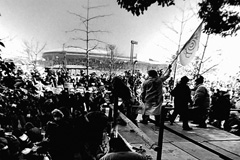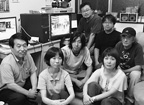Nippon Theater—Toward Film Inspired by the Sea
(“Nippon gekijo: Umi o hoho to shita eizo o!”) JAPAN / 2007 / Japanese, other / 16mm, Video / about 70 min / Four-screen multi-screening
JAPAN / 2007 / Japanese, other / 16mm, Video / about 70 min / Four-screen multi-screening
Production: Multi Screen Project
Cooperation with: NDU
Source: Planet Bibliothèque de Cinéma
Passionate warriors who believe in the history of cinema have gathered together ever since Nunokawa Tetsuro, a central figure in NDU (Japan Documentarist Union)—which went wild in the 1970s with works like Motoshinkakarannu—made his base in Osaka. The group has held many screenings in Kyoto and Osaka in an attempt to forge the future through multi-screen, as opposed to the typical single-screen, cinema. They are determined to achieve new heights at YIDFF. Though individual names don’t mean much in this anonymous group, the following are production members for this YIDFF version.

Staff: Ishida Midori, Kim Imman, Sato Reo, Shiraishi Yoshiko, Tainaka Tadashi, Nunokawa Tetsuro, Yasui Yoshio, Yoshida Ichiro
What is multi-screen cinema? Why do it? Four screens at the same time?
In 2003 we started shooting a documentary about the Shinsekai area in Osaka for the Multi Screen Project, which shows films on multiple screens simultaneously. The filming took place concurrently with a retrospective of the film production group NDU (Japan Documentarist Union) at Jazz Spot in Kyoto and Bar in Osaka.
The work documents Osaka’s Shinsekai area from the time of the “human exhibition” incident in 1903, when indigenous peoples from within Japan and around the world were put on display. Titled You Call That a Festival? We’re in the Midst of Putting It Together, this work used three screens and was shown at Kyoto University of Art and Design. It was based on the play Running Against the Wind, Turning Back the Hands of Time, which toured Japan with tent performances.
After the screening, one young member in the production declared that it was time to get serious about multi-screen film. The era of experimentation, extending back to the 1970 Osaka Expo, was over. But wait, does that mean that three-screen projects such as Palestine: Urgent Call (Tokyo Tobu Department Store, 1982) and To the Third World (Tokyo Metropolitan Art Museum, 1984) were experimental transition works?! Regardless, last year finally marked the arrival of serious multi-screen film with the presentation of a new work at Osaka’s PLANET+1. There wasn’t time to decide on a title. It was a program of four projections onto three screens, accompanied by live drums.
Historical background
In 1969, right around the time filming was completed for the documentary Onikko: A Record of the Struggle of Youth Laborers (1968, screened at YIDFF ’95), about young people protesting the Vietnam War, a nationwide general strike was proposed in US-occupied Okinawa. It was reminiscent of the “February 1 general strike”—about which we knew nothing other than the name—which had been declared in 1947 when all of Japan was occupied by the US, but ended in miscarriage.
Crossing to Okinawa still required a visa, and since the production members were turned down, they stowed away on a boat to make Motoshinkakarannu (1971, screened at YIDFF ’95).
In the documentary Asia Is One (1973, YIDFF 2005), we took up the history of the people of Miyako Island, the Koreans, the Taiwanese, and the Japanese as they passed through the Sakishima and Yaeyama islands, both with their own distinct cultures. It ends with the militaristic song “If I Go to Sea” against an everyday scene with aboriginal Taiwanese isolated in the mountains singing, “We want to go to war again.”
After that we dealt with the theme of national borders and people excluded from official national histories. These films include To the Japs: South Korean A-Bomb Survivors Speak Out (1971, YIDFF 2005), Notes on the Pacific War (1974), Bastard on the Border (1976, YIDFF ’95), Palestine 1976–1983: What We Learned from the Palestinian Revolution (1983, YIDFF ’97), Headhunter’s Song (2005, YIDFF 2005), and Big Stage in the Nagai Park Squatters’ Village (2007), protesting contemporary exclusionary policies.
A festival for transgressors in homogenized Japan
There was a humanistic flowering in the Japanese middle ages—the genesis of Japanese culture—when the seas were open, before the country was closed. In 2002, we encountered the struggle of indigenous Taiwanese whose ancestors had been forced to fight for the Japanese army in World War II and were later enshrined without permission at Yasukuni Shrine. That work became Headhunter’s Song. At YIDFF 2005, “Borders Within” program coordinator Yasui Yoshio presented Asia Is One and Headhunter’s Song, creating a zainichi historical space that retraced the century since the Sino-Japanese and Russo-Japanese wars.
The four oceans that border “postwar” Japan display the full spectrum of the rainbow, and call into question Japan’s modern national identity.
—Multi Screen Project
